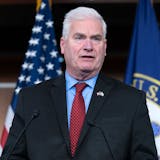Charitable gaming — the pulltabs and electronic games that were created to fund investments in community assets from ambulances to athletic fields — is enjoying boom times. Minnesotans are playing more, increasing revenue for the charities that operate the games by more than 13 percent in the last fiscal year ("Charitable gambling in Minnesota tops $1.5 billion in 2016," Jan. 6).
Yet, scratch the surface of the data and this reality becomes clear: The charities that operate the games with the intention of investing in their communities see nearly as much of their revenue go to finance the operations of state government as goes to local purposes. Instead of supporting community vitality, charitable gaming is becoming more and more of a hidden state tax.
Minnesotans expect to pay taxes, and charities that operate gaming for the sake of community investments are willing to pay their fair share. In recent years, though, their share has gone from fair to indefensible. The local veterans/fraternal/church/civic/youth/fire or police relief groups or any other organizations that conduct charitable gaming now pay a tax rate up to seven times higher than a for-profit business.
What is most harmful to the mission of these organizations is that they are taxed on every dollar, including their donations. The community-based groups pay up to 36 cents to the state for every dollar they are able to invest in making their towns and cities better and safer places to live. An organization raising funds to purchase an ambulance likely has to raise more than $108,000 — $80,000 for the cost of the ambulance itself and more than $28,000 to pay state taxes on the donation.
The irony is that all this is happening at a time when the vitality of rural communities has moved to the political spotlight. While charitable gaming is an important source of community investment funds for suburbs and other larger communities, it is especially critical to rural areas.
Many rural communities are at their tax capacity paying for essential services. It is charitable gaming that often provides the funds for a new emergency vehicle, a restored youth athletic facility, a park shelter or some other amenity that makes the community a more attractive and safer place to live.
The revenue generated by charitable gaming can sometimes blind policymakers and others to the facts. The amount Minnesotans spent on pulltabs, bingo and electronic games in the last fiscal year is substantial — about $1.5 billion. But nearly $1.3 billion of that was paid out in prizes, with virtually the entire amount remaining in Minnesota communities. The charities are remarkably efficient operations, spending less than 7 percent on average for overhead, including the cost of running and promoting the games.
After all the expenses are tallied, charities pay on average about 44 percent of the balance — the amount that would be considered "profit" in the business world — in taxes. The rest, $70 million, is left for the charitable mission.



